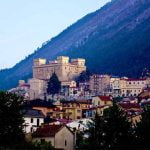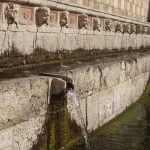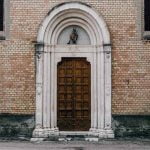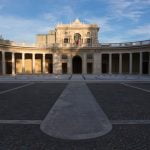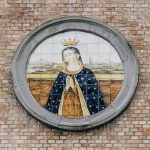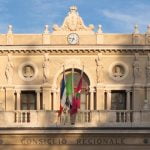Tucked away in the majestic snow-covered Apennine Mountains in the very heart of Italy is the city of L’Aquila. About an hour and a half from Rome, this small town is largely off the grid for most international travelers, making it one of Italy’s best kept secrets and true delights for those that do visit. This town of Old-World charm is beloved by its residents and welcomes travelers with open arms.
L’Aquila is the capital of both the Province of L’Aquila and the larger region of Abruzzo. With a population of approximately seventy thousand living on one hundred eighty square miles of land, the city is a fascinating maze of narrow streets that wind through the city, revealing treasures around every corner.
The city was established by Frederick II, the Holy Roman Emperor and King of Sicily, but was not completed until the thirteenth century by his son, Conrad IV. Since its establishment, the city has proven its strength and resilience over and over again after being subject to a series of attacks by enemy forces in the early years, and eventually earthquakes courtesy of Mother Nature.
In April 2009, the city of L’Aquila experienced an earthquake that caused great devastation. Many came to the city’s immediate aid, including attendees of the 2009 G8 Summit. Originally the G8 Summit was scheduled to be held in the Sardinian seaside city of La Maddalena, but it was moved to L’Aquila at the last minute so that funds could be brought into the area to help with the recovery effort.
Today, the city is rebuilding in the same spirit of resilience that it has shown in the past. A new generation studying at the University of L’Aquila may very well end up leading the way. The university boasts a student enrollment of eighteen thousand students engaged in more than sixty degree courses and eight research doctorate programs. A faculty of more than six hundred professors and researchers are helping to teach and mold this new generation that is rising up.
In addition to institutions such as the University of L’Aquila, visitors can see Renaissance and Baroque buildings and churches throughout the city located in various piazze, or city squares. In keeping with that thread of culture, the city has a strong history of operatic theater and symphony orchestra performances and is home to a fine arts academy, state conservatory, and film institute.
Transportation to L’Aquila is primarily via a railway station that runs trains to nearby towns such as Terni, Rieti, and Sulmona. When it comes to traveling inside the city limits, many of the residents and local college students prefer to travel by foot. Depending on the time of your visit, limited bus access may be available as well.
GEOGRAPHY
To say that L’Aquila is nestled in the heart of the Apennine Mountains is not an exaggeration. It is in fact a literal description of the city’s geography. At more than two thousand feet above sea level, the city is located in the Valley of the Aterno-Pescara, which sits between four mountain peaks that are each taller than six thousand feet.
The city is surrounded almost completely by the Apennine Mountain Range, and to the northeast, the snow–capped Gran Sasso d’Italia. The Gran Sasso is a secondary mountain massif of the Apennines. The unique landlocked position of the city sits atop an ancient lake bed that is thought to possibly enhance seismic activity.
CLIMATE
The surrounding high-rising mountain peaks are quite successful at blocking the Mediterranean Sea air from ever reaching the city. The result is a much cooler temperature in L’Aquila than what is found in the neighboring areas of Central Italy. The city is rather cool most of the year without going much above, on average, about eighty degrees Fahrenheit. Based on annual temperatures over the years, the warmest month to visit the city is August and the coolest is February.
ONLY IN L'AQUILA
One of the most unique pieces of architecture in the heart of L’Aquila is the Fountain of 99 Spouts, which is referred to as Fontana delle 99 Cannelle by locals. The thirteenth century structure is a trapezoid shape with horizontal rows of ninety-three water spouts over small rectangular pools. Six additional spouts were later added to a stone close to the fountain entrance to create a total of ninety-nine spouts. The wall above the tiles is a piece of artwork itself with alternating rows of red and white stone tiles. Historically, L’Aquila thrived on the close connection with local villages that once established the city as a federation. It is believed that the ninety-nine fountain spouts are a nod to the surrounding castles that participated in the city of L’Aquila’s founding.
The city of L’Aquila is full of culture that simply has a reverent splendor to it. Plan a visit to one of the gorgeous churches such as the Basilica of Santa Maria di Collemaggio, the L’Aquila Cathedral, or the Basilica of San Bernardino to behold stunning religious art and magnificent architecture. As you see the various landmarks, do not miss strolling through the main square of the city which is often a hub of activity for impromptu markets and social gatherings.
The city of L’Aquila is truly an Italian treasure found high in the snow-covered Apennine Mountains. This gorgeous city abounds with culture, close community, and a spirit of perseverance and resilience that is simply unparalleled. Journey to this lovely city to see the beauty, art, and warm people of Italy come alive and forever hold a special place in your heart.
*SPECIAL NOTE: While it is true the Italian city of L’Aquila experienced major devastation from the 2009 earthquake, the city continues to move forward and make progress with the rebuilding of the city. Some of the monuments and landmarks described in the narrative above are described in their pre-earthquake condition.
Travel Guides
[wudrelated include="1837"]
The Abruzzo Region of Italy
[wudrelated include="4239"]
The Cities of Abruzzo, Italy
[wudrelated include="4240"]
